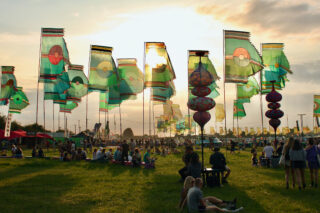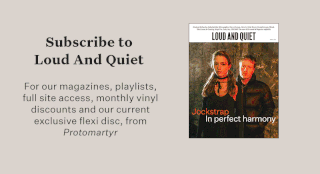Everything is bigger and better at Glastonbury, including my unexpected fits of crying
Over a weekend of intense heat, the last thing I needed for my dehydration was losing extra water through my eyes, but it kept happening

Over a weekend of intense heat, the last thing I needed for my dehydration was losing extra water through my eyes, but it kept happening
How do you write about a titan like Glastonbury? 200,000 people, 96 stages, 1000 artists, 1 million acres. It’s a lot to get down when you’re certain that everyone tuning in at home saw more than you, better than you, comfier than you. I recognised I needed some sort of plan, and I carried on recognising that until I was at Worthy Farm, and had been for some time.
Plans of any kind are very un-Glastonbury. It’s one of the festival’s greatest powers, and in this inclusive Shangri-La where we’re encouraged to live out our fantasies free from judgement for one weekend every summer, what most of us aim for is as simple as not giving so much of a shit for 4 or 5 days. For your own good, Glastonbury simply won’t allow you to behave like yourself. You can plan to meet at Lil Nas X under the “This is a mini-retirement” Gary Neville flag, but the flag holder will only wander off to talk to a Bodger & Badger tribute act; you can plan to see the start of Flohio in the Park and make it back to the Pyramid for Amadou & Mariam, but that’s a 30-minute site-long shuffle where you could meet anyone and absolutely anything could happen. It only takes an hour or two at Glastonbury to practically abandon everything and see how it goes, especially this year, it seemed, under a constant searing sun that made watching Max Richter open the Park Stage at 11am on Saturday (with Tilda Swinton as his neo classical ensemble’s narrator), feel like that might be you done for the day.
For years I never understood it when people said that they hardly saw any music at Glastonbury; that it wasn’t about that. I’m not quite ready to wholeheartedly agree, but I’ll concede that for me, at least, Glastonbury isn’t about music the way other festivals are; where I happily tear around discovering as much new music as possible, that we can then share through Loud And Quiet, on brand and, dare I say it, like a professional. I see Glastonbury predominantly as my chance to experience big pop acts, legendary heavyweights, and bands that I used to love and have stopped being embarrassed about how I used to love them. And now it’s 3:20pm on the final day of the Glastonbury and I’m crying again. This time to Yusuf/Cat Stevens.
I do a majority of my crying at music festivals these days. Not intentionally; it just happens. Usually the one time; usually out of nowhere; often to a song or band that holds little-to-no significance to me. Like ‘Watch The Corners’ by Dinosaur Jr – a song I quite like, from a band whose records I’ve never owned. I was side swiped by that one at Primavera in 2013, and so started a trend that for some reason doesn’t reach to solo gigs – or at least not indoor shows. It’s probably best that we don’t pull at this psychological thread now, but put it down to fresh air, the overwhelming nature of festivals on the whole, a passion shared communally at scale, the mysterious magic of music’s ability to punch you in the gut without warning, taking just a second to appreciate where you are, and a touchpaper of alcohol and fatigue, although not always.
In the everything-everywhere-all-at-once world of Glastonbury, I never stood a chance. When I welled up to The Lightning Seeds playing ‘Three Lions’, like the basic 40-year-old man that I sadly am, I should have known that that wasn’t my Glastonbury cry out of the way as early as 3pm on Friday afternoon. At least that song does mean a lot to me, a 13-year-old when it was first released and broke my heart in 1996. The whole band do, or did – a classic example of a group that I used to love and have stopped being embarrassed about how I used to love them. On the Other Stage, they simply played the hits (‘Marvellous’, ‘Perfect’, ‘Ready or Not’ etc. etc.) to a vast crowd of forgivable bucket hats – joyful, unpretentious, masterfully crafted songs by Ian Broudie, who was visibly touched by the number of people in front him. One of the few nearly-Brit Pop bands who never fully attracted a LADS-only following, despite ‘Three Lions’. And so it is at the Other Stage, and the whole of Glastonbury, whose ginormous size, for all its challenges, can’t help but allow for a far more diverse audience than smaller festivals, especially in its age range – helped no doubt by all those years of primetime BBC coverage. There’s a certain commonality, of course (in music and any visible politics), but once you get 200,000 people in a field, our echo chambers start to wobble if not collapse, which can only be a good thing.
The following day I fell victim to an artist even “less Loud And Quiet”, but, in actual fact, no less probable: Rick Astley. Whenever You Need Somebody was the first album I ever bought and duly hammered to death (at the age of 6), so I owed it to that peak version of myself to watch my childhood hero open the Pyramid in what would be Glastonbury 2023’s kitsch high point.
As you’ve probably heard by now, Astley had a very strong festival, practically turning his set into the Legend’s slot, what with Yusuf/Cat Stevens not being the kind of artist that security guards can dance in synchronisation to. If you didn’t see it live on TV, I’m not sure you need to watch this one back, but Astley deserves all the love he received for his riot of an hour, where he covered Harry Styles for a cheap but fun win (“Cheeky,” he Partridge’d as his keyboard player dropped the lick from ‘Take On Me’ into one of the breaks of ‘As It Was’), blow-dried his hair mid-song, and performed AC/DC’s ‘Highway to Hell’ from behind the drum kit more convincingly than anyone expected. He constantly dug himself out, giving fair warning more than once that “We do ‘Never Gonna Give You Up’ at the end, to keep you waiting” (“Show of hands, how many people have only come to hear ‘Never Gonna Give You Up’?” he asks at one point. “That’s not bad, only 99% of you.”), and besides all the knowing winks, he can still belt out a white soul vocal with the best of them, ensuring the whole show isn’t cloaked in tragic parody. Performance wise, this is what Glastonbury does best of all – unique, surprise moments brought on by a performer grasping their big chance, usually after a lifetime in the game. It’s the sort of thing that you get sick of hearing about if you weren’t there and swept up in it, but if you were it’s a reminder of how simple enjoyment in music is and should always be. I tweeted something as profound as that at the time, while my sunglasses filled up again. But like I said, Astley and I have history.

He got me (and many others) later that day too, when he performed a surprise set of Smiths covers with Blossoms as his backing band at Woodsies (formerly the John Peel tent). This time it was 100% the music, and being able to enjoy an hour of songs I’ve listened to perhaps more than anything else in my life, without the disappointing figure of Morrissey putting an awkward kink in the euphoria. Astley was a wit once again, ruining his new Savile Row suit with sweat, but it was the deep cuts that hit hardest: ‘Cemetry Gates’ and ‘Barbarism Begins at Home’. Blossoms have clearly studied their parts too, most notably when they performed the live opening of ‘Panic’ from Rank. And then there was the closing ‘There Is A Light That Never Goes Out’ – what else but a big blubbing sing-along for everyone in and around the area as the sun began to set. Back at my campsite soon after, the guy in the next tent asked how my day had been going so far. Before I could answer he said: “Because I just cried all of the water out of my body watching Rick Astley cover The Smiths.”
There are other eye-watering moments at Glastonbury, of course, for other reasons. Like when you’re charged £3 for a warm can of Coke that says 85p on it. And the smell, which you can never convince your brain is 90% the cows, however much you tell it to yourself. Yusuf/Cast Stevens was also not quite cry-with-laughter funny, but more than a little bit unintentionally hilarious. If he’d been told what the famous, celebratory Legend’s slot is all about, he did a brilliant job of ignoring it completely, as is his right. His acoustic lullabies of peace aren’t for jumping around to anyway, but he performed them as if he was playing in a small jazz club in Soho – earnest and not remotely overwhelmed by what was surely the biggest crowd he’s ever performed to. He made jokes and double entendre drug references without knowing it (“I once went on tour with Jimi Hendrix… it was pretty… wacky”), and his video visuals were either charmingly on the nose (a cartoon of a train with a peace sign for its face for ‘Peace Train’) or as subtle as dynamite, like when his cover of ‘Here Comes The Sun’ is performed in front of a black and white photograph of George Harrison laid over a sun painted in the style of Van Gogh. Towards the end of the song, a photo of Glastonbury Tor then incongruously completed the image, but I think he got away with it.
And yet it was this hour that my tear ducts had been warming up for. Exhausted and by now what else but severely sunburnt, with the end of Glastonbury looming and reality the other side of it, I was losing water fast. How do people perform here when it can be this emotional to watch, I thought? I had sent a video of Stevens to my mum when he walked on, like she’d asked me to, and she had texted me back simply: “I love you”, so I was doomed I suppose, even if, like Dinosaur Jr and many others, Stevens is not my guy. He does, however, come with a heavy arsenal of the most beautiful songs designed specifically to make you think about your life and the moments that have brought you here: ‘The First Cut Is The Deepest’ (cruelly tossed out as part of an early ’60s medley), ‘Wild World’, the closing, devastating ‘Father and Son’. It didn’t even help to focus on the giant photo of Nina Simone that accompanied a rendition of ‘Don’t Let Me Be Misunderstood’, with her name displayed in a clumsy, enormous default PowerPoint font, which once said ‘Your text here’ in its place. That Stevens’ voice and music can push on through that is almost as incredible as Glastonbury’s ability to strip away the snobbery of music, and reconnect you with the unashamed sobbing joy of it all.
Photography by Tom Widd